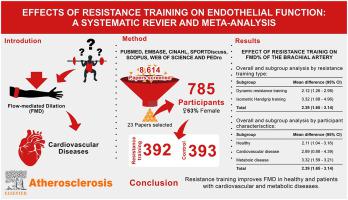Atherosclerosis ( IF 4.9 ) Pub Date : 2021-08-03 , DOI: 10.1016/j.atherosclerosis.2021.07.009 Jessika Karla T N F Silva 1 , Annelise L Menêses 2 , Belinda J Parmenter 3 , Raphael M Ritti-Dias 4 , Breno Q Farah 5

|
Background and aims
The effects of resistance training on flow-mediated dilation (FMD), which has been the gold standard non-invasive assessment of endothelial function and is associated with the risk of cardiovascular events, are not well known. We conducted a systematic review to analyze the effects of resistance training on FMD.
Methods
We searched Pubmed, Embase, CINAHL, SPORTDiscuss, Scopus, Web of Science and PEDro databases for studies that met the following criteria: (a) randomized controlled trials of resistance exercise with a comparative non-exercise group or contralateral untrained limb in adults and/or elderly; (b) studies that measured post-occlusion brachial artery FMD by ultrasonography, before and after intervention. Mean differences (MDs) with 95 % confidence interval (95 % CI) were calculated using an inverse variance method with a random effects model.
Results
Twenty-three studies were included in the meta-analysis (n = 785 participants; 53 % females). Resistance training on FMD responses showed a favorable result for the resistance training group (n = 366) compared to the control group (n = 358) (MD 2.39, 95%CI 1.65, 3.14; p<0.00001). Subgroup analysis indicated favorable results for the dynamic resistance training (n = 545; MD 2.12, 95 % CI 1.26, 2.98; p<0.00001) and isometric handgrip training (n = 179; MD 3.32, 95 % CI 1.68, 4.96; p<0.0001) compared to the control group. The effect of resistance training on FMD responses was also favorable regardless of the condition of the participants (Healthy [n = 261]: MD 2.11, 95 % CI 1.04, 3.18; p<0.0001; Cardiovascular disease [n = 310]: MD 2.89, 95 % CI 0.88, 4.90; p = 0.005; metabolic disease [n = 153]: MD 2.40, 95 % CI 1.59, 3.21; p<0.00001).
Conclusions
Resistance training improves FMD in healthy individuals and patients with cardiovascular and metabolic diseases.
中文翻译:

阻力训练对内皮功能的影响:系统回顾和荟萃分析
背景和目标
阻力训练对血流介导扩张 (FMD) 的影响并不为人所知,FMD 一直是内皮功能的金标准非侵入性评估,并且与心血管事件的风险相关。我们进行了一项系统回顾,以分析阻力训练对 FMD 的影响。
方法
我们在 Pubmed、Embase、CINAHL、SPORTDiscuss、Scopus、Web of Science 和 PEDro 数据库中搜索了符合以下标准的研究:(a) 阻力训练随机对照试验与非运动组或对侧未训练肢体的成人和/或老人;(b) 在干预前后通过超声检查测量闭塞后肱动脉 FMD 的研究。使用具有随机效应模型的逆方差法计算具有 95% 置信区间 (95% CI) 的平均差 (MD)。
结果
荟萃分析中包含 23 项研究(n = 785 名参与者;53% 为女性)。与对照组 (n = 358) 相比,阻力训练组 (n = 366) 对 FMD 反应的阻力训练显示出有利的结果 (MD 2.39, 95%CI 1.65, 3.14; p < 0.00001 )。亚组分析表明动态阻力训练(n = 545;MD 2.12,95% CI 1.26,2.98;p< 0.00001)和等长握力训练(n = 179;MD 3.32,95% CI 1.68,4.96;p< 0.0001) 与对照组相比。无论参与者的状况如何,阻力训练对 FMD 反应的影响也是有利的(健康 [n = 261]:MD 2.11,95% CI 1.04,3.18;p <0.0001;心血管疾病 [n = 310]:MD 2.89,95% CI 0.88,4.90;p = 0.005;代谢性疾病 [n = 153]:MD 2.40,95% CI 1.59,3.21;p < 0.00001)。
结论
阻力训练可改善健康个体和患有心血管和代谢疾病的患者的口蹄疫。











































 京公网安备 11010802027423号
京公网安备 11010802027423号